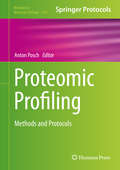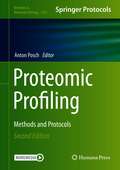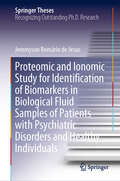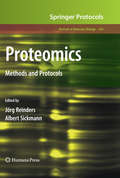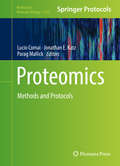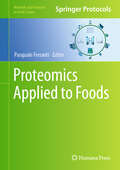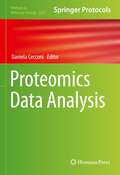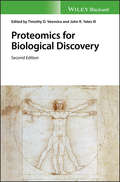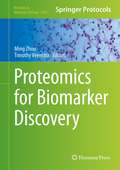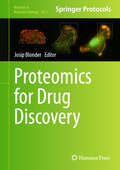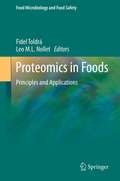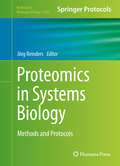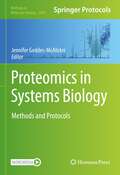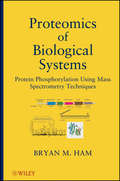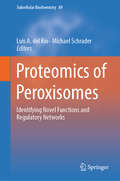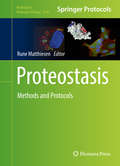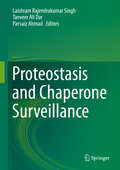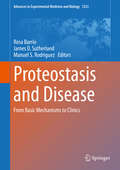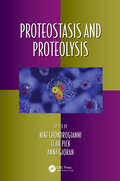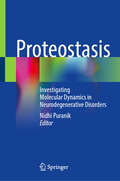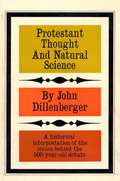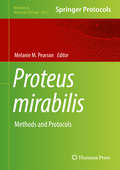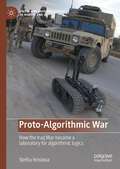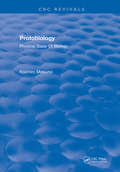- Table View
- List View
Proteomic Profiling
by Anton PoschThis volume presents the latest developments of the main pillars of protein analysis, such as sample preparation, separation and characterization. The book begins by describing basic but important sample preparation protocols. It then goes on to describe more sophisticated procedures on enriching specific protein classes and concludes with detailed descriptions of integrated work-flows for comprehensive protein analysis and characterization. The authors of the individual chapters are renowned protein biochemists who have all set value to provide a detailed representation of their lab work. Throughout the chapters, these authors share important tips and tricks for a successful and reproducible employment of their protocols in other laboratories. Written in the highly successful Methods in Molecular Biology series format, chapters include introductions to their respective topics, lists of the necessary materials and reagents, step-by-step, readily reproducible laboratory protocols and tips on troubleshooting and avoiding known pitfalls. Authoritative and cutting-edge, Proteomic Profiling: Methods and Protocols is the perfect guide for students of Biochemistry, Biomedicine, Biology, and Genomics and will be an invaluable source for the experienced, practicing scientists.
Proteomic Profiling: Methods and Protocols (Methods in Molecular Biology #2261)
by Anton PoschThis detailed new edition presents the latest developments of the main pillars of protein analysis, namely sample preparation, separation, and characterization. Core areas in this volume are protocols for the analysis of post-translational modifications and protein interaction partners, followed by sophisticated procedures to enrich for extracellular vesicles and organelles, along with several types of protein immuno-assays complemented by various methods for the characterization of antibodies and host-cell protein analysis. Last but not least, a few standard sample preparation protocols and recent advances concerning immuno-chemical detection of proteins are included as well. Written for the highly successful Methods in Molecular Biology series, chapters include introductions to their respective topics, lists of the necessary materials and reagents, step-by-step, readily reproducible laboratory protocols, and tips on troubleshooting and avoiding known pitfalls. Authoritative and up-to-date, Proteomic Profiling: Methods and Protocols, Second Edition serves as an ideal reference for students of biochemistry, biomedicine, biology, and genomics and will be an invaluable source for the experienced, practicing scientist as well.
Proteomic and Ionomic Study for Identification of Biomarkers in Biological Fluid Samples of Patients with Psychiatric Disorders and Healthy Individuals (Springer Theses)
by Jemmyson Romário de JesusThis book presents an exploratory analysis based on proteomic and ionomics studies comparing the blood serum of patients with bipolar disorder (BD), healthy controls, patients with schizophrenia (SCZ), and patients with other disorders (OD) in order to identify biomarkers of BD. Bipolar disorder is a psychiatric condition that affects thousands of people worldwide. The absence of biomarkers for BD has resulted in misdiagnosis and ineffective treatment in some patients, causing additional health problems and high costs for health systems. As such, this book evaluates various strategies for sample preparation for proteomic and ionomic studies in order to simplify complex serum samples and allow the quantification of chemical species (proteins and metal ions), which are potential candidates for BD biomarkers. In addition, it describes the development of a new membrane-based methodology for extracting urine proteins to be used in biomarker discovery.
Proteomics
by Albert Sickmann Jörg ReindersSince the development of the concept of "proteomics", great progress has granted deeper insight into the cellular network, but the enormous range of protein abundance, dynamics, and interactions leaves many further challenges in the field. In Proteomics: Methods and Protocols, experts in proteomic research have contributed detailed techniques, which present an overview of the contemporary challenges and possibilities in the various areas of proteomics, as well as cutting-edge protocols that provide concrete examples for successful proteome analysis. Written in the clear and concise Methods in Molecular BiologyTM series format, chapters include introductions to their respective topics, lists of the necessary materials and reagents, step-by-step, readily reproducible laboratory protocols, and notes on troubleshooting and avoiding known pitfalls. Authoritative and easy-to-use, Proteomics: Methods and Protocols will serve as a valuable reference book for laboratories around the world and raise interest in the complex and vital field of proteomics research.
Proteomics
by Parag Mallick Lucio Comai Jonathan E. KatzThis volume aims to provide protocols on a wide range of biochemical methods, analytical approaches, and bioinformatics tools developed to analyze the proteome. Written in the highly successful Methods in Molecular Biology series format, chapters include introductions to their respective topics, lists of the necessary materials and reagents, step-by-step, readily reproducible laboratory protocols, and tips on troubleshooting and avoiding known pitfalls. Authoritative and cutting-edge, Proteomics: Methods and Protocols aims to ensure successful results in the further study of this vital field.
Proteomics Applied to Foods (Methods and Protocols in Food Science)
by Pasquale FerrantiThis volume illustrates advanced methods on proteomic procedures in food science and nutrition. Chapters offer a comprehensive view of food proteomics applications, detailing modern instruments and methods of proteomics, impact of protein composition on our current understanding of availability of and micronutrients, and principles and practices of hurdle and green food proteomios. Written in the format of the Methods and Protocols in Food Science (MeFS) series, the chapters include an introduction to the respective topic, list necessary materials and reagents, detail well-established and validated methods for readily reproducible laboratory protocols, and contain notes on how to avoid or solve typical problems. Authoritative and cutting-edge, Proteomics Applied to Foods aims to provide enables students and researchers in food science and nutrition the latest tools to advance their research and open up new areas of food and nutrition investigation.
Proteomics Data Analysis (Methods in Molecular Biology #2361)
by Daniela CecconiThis thorough book collects methods and strategies to analyze proteomics data. It is intended to describe how data obtained by gel-based or gel-free proteomics approaches can be inspected, organized, and interpreted to extrapolate biological information. Organized into four sections, the volume explores strategies to analyze proteomics data obtained by gel-based approaches, different data analysis approaches for gel-free proteomics experiments, bioinformatic tools for the interpretation of proteomics data to obtain biological significant information, as well as methods to integrate proteomics data with other omics datasets including genomics, transcriptomics, metabolomics, and other types of data. Written for the highly successful Methods in Molecular Biology series, chapters include the kind of detailed implementation advice that will ensure high quality results in the lab. Authoritative and practical, Proteomics Data Analysis serves as an ideal guide to introduce researchers, both experienced and novice, to new tools and approaches for data analysis to encourage the further study of proteomics.
Proteomics Sample Preparation
by Jörg Von HagenThis long-awaited first guide to sample preparation for proteomics studies overcomes a major bottleneck in this fast growing technique within the molecular life sciences. By addressing the topic from three different angles -- sample, method and aim of the study -- this practical reference has something for every proteomics researcher. Following an introduction to the field, the book looks at sample preparation for specific techniques and applications and finishes with a section on the preparation of sample types. For each method described, a summary of the pros and cons is given, as well as step-by-step protocols adaptable to any specific proteome analysis task.
Proteomics for Biological Discovery
by Timothy D. Veenstra John R. Yates IIIAn update to the popular guide to proteomics technology applications in biomedical research Building on the strength of the original edition, this book presents the state of the art in the field of proteomics and offers students and scientists new tools and techniques to advance their own research. Written by leading experts in the field, it provides readers with an understanding of new and emerging directions for proteomics research and applications. Proteomics for Biological Discovery begins by discussing the emergence of proteomics technologies and summarizing the potential insights to be gained from proteome-level research. The tools of proteomics, from conventional to novel techniques, are thoroughly covered, from underlying concepts to limitations and future directions. Later chapters provide an overview of the current developments in post-translational modification studies, structural proteomics, biochemical proteomics, applied proteomics, and bioinformatics relevant to proteomics. Chapters cover: Quantitative Proteomics for Differential Protein Expression Profiling; Protein Microarrays; Protein Biomarker Discovery; Biomarker Discovery using Mass Spectrometry Imaging; Protein-Protein Interactions; Mass Spectrometry Of Intact Protein Complexes; Crosslinking Applications in Structural Proteomics; Functional Proteomics; High Resolution Interrogation of Biological Systems via Mass Cytometry; Characterization of Drug-Protein Interactions by Chemoproteomics; Phosphorylation; Large-Scale Phosphoproteomics; and Probing Glycoforms of Individual Proteins Using Antibody-Lectin Sandwich Arrays. Presents a comprehensive and coherent review of the major issues in proteomic technology development, bioinformatics, strategic approaches, and applications Chapters offer a rigorous overview with summary of limitations, emerging approaches, questions, and realistic future industry and basic science applications Features new coverage of mass spectrometry for high throughput proteomic measurements, and novel quantitation strategies such as spectral counting and stable isotope labeling Discusses higher level integrative aspects, including technical challenges and applications for drug discovery Offers new chapters on biomarker discovery, global phosphorylation analysis, proteomic profiling using antibodies, and single cell mass spectrometry Proteomics for Biological Discovery is an excellent advanced resource for graduate students, postdoctoral fellows, and scientists across all the major fields of biomedical science.
Proteomics for Biomarker Discovery
by Timothy Veenstra Ming ZhouWith the advent of proteomics came the development of technologies, primarily mass spectrometry, which allowed high-throughput identification of proteins in complex mixtures. While the mass spectrometer resides at the heart of proteomics, its ability to characterize biological samples is only as good as the sample preparation and data analysis tools used in any study. In Proteomics for Biomarker Discovery, expert researchers in the field detail many of the methods which are now commonly used to study proteomics. These include methods and techniques include both label-free approaches and those that utilize stable isotopes incorporated both during cell growth or added via a chemical reaction once the proteome is extracted from the cell. Written in the highly successful Methods in Molecular BiologyTM series format, chapters include introductions to their respective topics, lists of the necessary materials and reagents, step-by-step, readily reproducible laboratory protocols, and key tips on troubleshooting and avoiding known pitfalls. Authoritative and practical, Proteomics for Biomarker Discovery seeks to aid scientists in the further study the different sample preparation and data analysis tools used in proteomics today.
Proteomics for Drug Discovery (Methods in Molecular Biology #2823)
by Josip BlonderThis detailed volume explores a wide range of experimental and bioinformatic proteomics methods applicable to the drug discovery process. Focused on drug target discovery, validation, characterization, and quantitation, the book delves into bottom-up data-dependent (DDA) shotgun and data-independent acquisition (DIA) proteomics, cell surface proteomics, proteogenomics, chemoproteomics, methodologies focused on posttranslational modifications, single cell proteomics, 3D cell culture proteomics, organoids, and laser capture microdissection (LCM) assisted tissue proteogenomics. Advanced quantitative techniques, which include label-free, mass tagging, and targeted immuno-MRM proteomics, along with top-down proteomics for validation and characterization of selected protein targets, are also described. Written for the highly successful Methods in Molecular Biology series, chapters include introductions to their respective topics, lists of the necessary materials and reagents, step-by-step and readily reproducible laboratory protocols, and tips on troubleshooting and avoiding foreseeable pitfalls. Authoritative and practical, Proteomics for Drug Discovery serves as an ideal guide for researchers striving to push the field of drug discovery via MS-based proteomics to new frontiers.
Proteomics in Foods
by Fidel Toldrá Leo M. NolletFood proteomics is one of the most dynamic and fast-developing areas in food science. The goal of this book is to be a reference guide on the principles and the current and future potential applications of proteomics in food science and technology. More specifically, the book will discuss recent developments and the expected trends of the near future in food proteomics. The book will be divided into two parts. The first part (7 chapters) will focus on the basic principles for proteomics, e.g., sample preparation, such as extraction and separation techniques, analytical instrumentation currently in use, and available databases for peptide and protein identification. The second part of the book (26 chapters) will focus on applications in foods. It will deal with quality issues related to post-mortem processes in animal foods and quality traits for all foods in general, as well as the identification of bioactive peptides and proteins, which are very important from the nutritional point of view. Furthermore, consumers are now extremely susceptible to food safety issues, and proteomics can provide reassurance with different safety aspects, such as food authenticity, detection of animal species in the food, and identification of food allergens. All of these issues will be covered in this book. It is also worth noting that both editors are internationally recognized experts in the field of food science, and both have edited numerous food science books and handbooks.
Proteomics in Systems Biology: Methods and Protocols (Methods in Molecular Biology #1394)
by Jörg ReindersThis volume presents an overview of contemporary quantitative proteomics methods along with instructions on data interpretation, while providing examples on how to implement proteomics into systems biology. Written in the highly successful Methods in Molecular Biology series format, chapters include introductions to their respective topics, lists of the necessary materials and reagents, step-by-step, readily reproducible laboratory protocols, and tips on troubleshooting and avoiding known pitfalls. Thorough and practical, Proteomics in Systems Biology: Methods and Protocols is a valuable resource for researchers who are interested in using proteomics techniques to help answer biological and medical questions.
Proteomics in Systems Biology: Methods and Protocols (Methods in Molecular Biology #2456)
by Jennifer Geddes-McAlisterThis detailed book highlights the diverse techniques and applications of proteomics in an accessible, informative, and concise manner. The collection features sample preparation from distinct extraction, quantification, enrichment, modification, as well as interactome methodology for the in-depth exploration of biological systems, and the application of proteomics to clinical, infectious disease, and agricultural practices. Moreover, cutting-edge bioinformatics tools, encompassing machine learning and data integration strategies, are explored, as are techniques expanding beyond proteomics into the realm of metabolomics. Written for the highly successful Methods in Molecular Biology series, chapters include introductions to their respective topics, lists of the necessary materials and reagents, step-by-step, readily reproducible laboratory protocols, and tips on troubleshooting known pitfalls. Comprehensive and practical, Proteomics in Systems Biology: Methods and Protocols emphasizes the importance of proteomics and demonstrates a plethora of approaches for investigating diverse biological entities from a systems perspective.
Proteomics of Biological Systems
by Bryan M. HamPhosphorylation is the addition of a phosphate (PO4) group to a protein or other organic molecule. Phosphorylation activates or deactivates many protein enzymes, causing or preventing the mechanisms of diseases such as cancer and diabetes. This book shows how to use mass spectrometry to determine whether or not a protein has been correctly modified by the addition of a phosphate group. It also provides a combination of detailed, step-by-step methodology for phosphoproteomic sample preparation, mass spectral instrumental analysis, and data interpretation approaches. Furthermore, it includes the use of bioinformatic Internet tools such as the Blast2GO gene ontology (GO) tool, used to help understand and interpret complex data collected in these studies.
Proteomics of Peroxisomes: Identifying Novel Functions And Regulatory Networks (Subcellular Biochemistry #89)
by Luis A. del Río Michael SchraderThis new edited volume in the Springer Subcellular Biochemistry Series presents a comprehensive, state-of-the-art overview of the proteomics of peroxisomes derived from mammalian, Drosophila, fungal, and plant origin, and contains contributions from leading experts in the field. The development of sensitive proteomics and mass spectrometry technologies, combined with bioinformatics approaches now allow the identification of low-abundance and transient peroxisomal proteins and permits to identify the complete proteome of peroxisomes, with the consequent increase of our knowledge of the metabolic and regulatory networks of these important cellular organelles. The book lines-up with these developments and is organized in four sections including: (i) mass spectrometry-based organelle proteomics; (ii) prediction of peroxisomal proteomes; (iii) analysis of peroxisome proteome interaction networks; and (iv) peroxisomes in relation to other subcellular compartments. The editor Luis A. del Río is Professor ad honorem of the Spanish National Research Council (CSIC) in the Group of Antioxidants, Free Radicals and Nitric Oxide in Biotechnology, Food and Agriculture, Department of Biochemistry and Cell & Molecular Biology of Plants, at the Estación Experimental del Zaidín, Granada, Spain. Del Río’s research group focuses on the metabolism of reactive oxygen species (ROS), reactive nitrogen species (RNS) and antioxidants in plant peroxisomes, and the ROS- and RNS-dependent role of peroxisomes in plant cell signalling. The editor Michael Schrader is Professor of Cell Biology & Cytopathology in the Department of Biosciences at the University of Exeter, UK. Using mammalian peroxisomes as model organelles, Prof. Schrader and his team aim to unravel the molecular machinery and signalling pathways that mediate and regulate the formation, dynamics and abundance of these medically relevant cellular compartments.
Proteostasis
by Rune MatthiesenThis volume highlights the role of proteostasis in human health and associated disease model systems, reflecting its rising importance which has led to the development of new technologies to obtain insight into underling protein mechanistic events. Written in the highly successful Methods in Molecular Biology series format, chapters include introductions to their respective topics, lists of the necessary materials and reagents, step-by-step, readily reproducible laboratory protocols, and tips on troubleshooting and avoiding known pitfalls. Authoritative and cutting-edge, Proteostasis: Methods and Protocols aims to become a reference book on proteostasis in human health.
Proteostasis and Chaperone Surveillance
by Parvaiz Ahmad Laishram Rajendrakumar Singh Tanveer Ali DarProteostasis is central to the development of various human diseases caused due to excessive protein misfolding and the disregulation of the protein quality control system. In this book, respected researchers from many leading institutions contribute their insights on proteostasis maintenance. The coverage mainly focuses on the basics of maintaining proteostasis, the consequences of proteostatic system failure, and how chaperone systems constantly maintain proteostasis. In addition, the book presents in detail different treatment strategies for diseases caused by proteostatic system failure, as well as the inhibition of proteostatic failure using small molecule compounds. It examines advances in the modulation of proteopathies, providing a comprehensive source of key mechanistic insights on these diseases. As such, the book offers a valuable resource for beginners and more experienced investigators alike who are looking for detailed and reliable information on protein homeostasis, the diseases that can develop due to related imbalances and the essential role of molecular and chemical chaperones.
Proteostasis and Disease: From Basic Mechanisms to Clinics (Advances in Experimental Medicine and Biology #1233)
by Manuel S. Rodriguez Rosa Barrio James D. SutherlandThis book, written by members of the European network PROTEOSTASIS, provides an up-to-date review of the research regarding protein homeostasis in health and disease. With new discoveries contributing to the increasing complexity of this topic, the book offers a detailed overview of the pathways regulating protein homeostasis, including autophagy and the ubiquitin protein family. Following a basic introduction, it explains how defects in protein homeostasis contribute to numerous pathologies, including cancer, neurodegeneration, inflammation and a number of rare diseases. In addition, it discusses, the role of protein homeostasis in cellular development and physiology. Highlighting the latest research in the field of protein homeostasis and its implications for various clinically relevant diseases, the book appeals to researchers and clinicians, while also offering a reference guide for scholars who are new to the field.
Proteostasis and Proteolysis (Oxidative Stress and Disease #46)
by Niki Chondrogianni Elah Pick Anna GioranProteostasis integrates biological pathways controlling biogenesis, trafficking, folding, and degradation of proteins. This book focuses on two protein breakdown/degradation processes (proteolysis), which are part of a normally functioning proteostatic system: the ubiquitin-proteasome system and autophagy.
Proteostasis: Investigating Molecular Dynamics in Neurodegenerative Disorders
by Nidhi PuranikThis book explores the role of proteostasis in neurodegenerative disorders, focusing on protein homeostasis in long-lived, nondividing cells like neurons. It examines how disruptions in proteostasis, influenced by factors such as oxidative stress, aging, and environmental stress, contribute to diseases like Alzheimer&’s, Parkinson&’s, and amyotrophic lateral sclerosis. The book begins with an overview of the epidemiology and management of neurodegenerative diseases. Subsequent chapters delve into the mechanisms governing proteostasis, highlighting the ubiquitin-proteasome system, molecular chaperones, and co-chaperones in protein folding and degradation. It further explores how impairments in these pathways contribute to neuroinflammation and disease progression. By providing insights into these cellular processes, the book aims to enhance understanding and support the development of potential therapeutic strategies.
Protestant Thought and Natural Science: A Historical Interpretation
by John DillenbergerProtestant Thought and Natural Science presents a concise interpretation of the relations between natural scientists and Protestant theologians from the Reformation to the present day. The book penetrates behind the skirmishes to the underlying issues in a manner not achieved before. From the introduction: "This volume is not a history of the conflicts between theology and science nor of the harmony between the two. It is, however, an attempt to penetrate behind the concrete issues, of which we all are aware in some form or another, to the underlying problems which exercised the major parties in the debates." John Dillenberger’s firsthand knowledge of the source material has enabled him to break through the “science-and-religion” stereotype in an account at once complex and interesting.
Proteus mirabilis: Methods and Protocols (Methods in Molecular Biology #2021)
by Melanie M. PearsonThis detailed volume explores essential protocols for the study of Proteus mirabilis which, despite its genetic relatedness to species such as E. coli, often requires specialized handling techniques. This opportunistic bacterial pathogen, most often known as a causative agent of complicated urinary tract infection, is addressed in chapters from global experts in the field. Written for the highly successful Methods in Molecular Biology series, chapters include introductions to their respective topics, lists of the necessary materials and reagents, step-by-step, readily reproducible laboratory protocols, and tips on troubleshooting and avoiding known pitfalls. Authoritative and practical, Proteus mirabilis: Methods and Protocols serves as an ideal guide for researchers intrigued by the renewed appreciation for the medical impact and environmental adaptability of this organism, coupled with continued fascination for its dynamic behavior.
Proto-Algorithmic War: How the Iraq War became a laboratory for algorithmic logics (Social and Cultural Studies of Robots and AI)
by Stefka HristovaDuring the Iraq War, American soldiers were sent to both fight an enemy and to recover a “failed state” in pixelated camouflage uniforms, accompanied by robots, and armed with satellite maps and biometric hand-held scanners. The Iraq War, however, was no digital game: massive-scale physical death and destruction counter the vision of a clean replayable war. The military policy of the United States, and not the actual experience of war, has been rooted in the logic of digital, and nascent algorithmic technology. This logic attempted to reduce culture, society, as well as the physical body and environment into visual data that lacks cultural and historical context. This book details the emergence of a nascent algorithmic war culture in the context of the Iraq War (2003-2010) in relation to the data-driven early 20th century British Mandate for Iraq. Through a series of five inquiries into the ways in which the Iraq War attempted to and often failed to see population and territory as digital and further proto-algorithmic entities, it offers an insight into the digitization and further unmanned automaton of war. It does so through a comparative historical framework reaching back to the quantification techniques harnessed during the British Mandate for Iraq (1918-1932) in order to explicate the parallels and complicated the diversions between the numerical logics that have driven both military state-building enterprises.
Protobiology Physical Basis Of Biology
by K. MatsunoProtobiology as a physics of becoming emphasizes the dynamics underlying conservation laws, whereas the physics of being emphasize the dynamics presupposing conservation laws. Protobiology thus concerns itself with a convoluted problem of how both the law of motion and its boundary conditions develop with time without forgetting that these two are inseparable, in contrasts to the physics of being that assumes separability.
